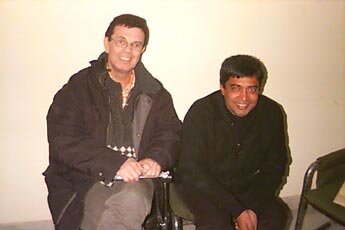 |
|||||
|
|||||
|
Amitayush Vyas and Roger Choate are members of Civil Society Partnership Programme of Varanasi-based Sankat They spoke to EcoFriends and reflected their views on the Ganga pollution and how it should be handled. How do you see the magnitude of the pollution problem in Ganga? Roger: Magnitude varies tremendously from one part of Ganga to the other. Some parts of it are very clean, some parts are only partly polluted. In Kanpur, Ganga’s pollution is the worst. I do not know if anybody knows the extent of total pollution along the entire length of the river except for the government who are supposed to be monitoring this. But they tend to keep it a secret. Amitayush: To me the magnitude of the problem is immense. This is because nothing has been done about containing its pollution. I find that nobody is concerned about the river. We have got funds. We have the technical know-how to treat the effluents. Still, Ganga’s state is deteriorating. Where is the shortcoming? Roger: From what I understand, no major river in the world has been cleaned without a public pressure campaign which questions the proper use of grant made by the authorities. That’s been true for Thames, Houdsen river and that has to be true for Ganga. Money is there, technology and expertise is available. But what’s lacking is the political will. No political party has Ganga on its agenda. So what we have to do is to make sure that Ganga gets a place in their agenda. Only through pressure can this be achieved. Amitayush: The Ganga Action Plan (GAP) did not work up to the total capacity. So at some levels, the government has failed. But at the same time, the citizens are also not concerned. So these two combined have made the problem huge. Until these are handled simultaneously, I see the river getting more polluted in the coming years. Don’t you think it is a paradox that we pollute the same river which we rever as our Mother? Amitayush: To me it is a paradox but to a Hindu mind it is not because they think that Ganga can’t be polluted as it has self-purification power. May be, it’s time that we start showing them that there indeed is a paradox. Roger: Religions always contain paradoxes, so I am not very surprised. Religious devouts do not fully understand the situation. We would have to be see what would happen if religious paradoxes became public knowledge, that many rituals release toxics which can kill you. How do you link Ganga pollution with the health impact? Roger: I think by making a linkage between health and river we can win this game. Because people are dying from water-borne diseases. Almost half of the Indian population is dependent on Ganga and its tributaries. First, we should have a nature health drive. By dramatizing the health impact, we may garner public support. Amitayush: Water pollution is not a concern only for the present generation but also for the future generations because we know that by 2020, we will be left with only one third of the freshwater reserves of what we have today. Amitayush: Our campaign is focusing on public awareness. We are trying to generate a sustainable concern among the people across India. We have a couple of programmes like riverfront cleaning and providing facilities to village people affected by Ganga contamination. We are trying to do some civil society partnership programmes like opinion-making exercise and a dialogue with various groups who can take action against pollution. Roger: When we talk of having a dialogue there has to be a linkage between the river and something which engages people’s attention. We should try to develop a vision of Ganga. I mean what it would feel like if Ganga becomes clean. Why do you think GAP failed? Was it because it did not involve people? Amitayush: I do not think there was anything wrong in GAP I for not having involved people. It was more of a technology-oriented thing. There was not much scope for involving people in containing the point sources of pollution. But when it comes to non-point sources of pollution, there is a lot of scope. And government has not done enough on this front. That’s why NGOs like Sankat Mochan Foundation and Eco Friends are there, to extend the work of the government. The GAP I did not focus on the non-point sources which it should have had. Roger : There were no watchdog groups which could oversee the functioning of the project. The process in GAP I was not transparent enough. One wonders why the government does not go for a cheaper technology to treat sewage which is non-electrical. There are technologies in which contaminated water is channelised by force of gravity to biological plants where water is treated biologically. I hope the failures of GAP I should help in making GAP II more effective. |
|||||
|
|
|||||
|
|
|||||
|
About Us | About Kanpur | About Ganga | GAP | Activities | Accomplishment | Projects | Eco Talk | Reports | Contact | Support Us |
|||||
|
